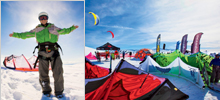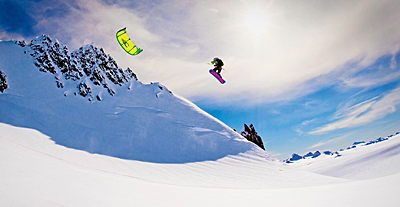sierraclub.org - sierra magazine - november/december 2009 - second wind


Second Wind
A Snowkiting Newbie Rises From the Wreckage
By Emmett Berg. Photography by Richard Hallman
GO FLY A KITE

Left: "Hey, I meant to do that pile driver." Right: the 2009 Snowkite Masters in Skyline, Utah.
Snowkiting evokes a Leonardo da Vinci sketch of an ornithopter circa 1500, but the sport--whose precise origins are disputed--is only a few decades old. Polar expeditions have employed kites since 1888, when Fridtjof Nansen and his team sent groundsheets aloft to pull sledges across Greenland. The evolution of foil kites in the 1960s and '70s and the popularity of waterskiing and windsurfing were influential precursors. In the 1980s a Wisconsin man sold large delta kites to pull skiers across frozen lakes, and in 1987 a father-son team in the Pacific Northwest began building kites to pair with water skis.
Wide-open spaces are a must. Coming too close to anyone or anything can result in embarrassment or tragedy. Ski resorts don't allow them, but snowkiters often have the run of ridgelines and frozen lakes. Because those places are also popular for snowmobiling and ice fishing, the prevailing etiquette is to communicate with those around you before you launch.
A few places in the United States, such as Montana's Georgetown Lake and Utah's Skyline Ridge, have bona fide snowkiting communities. Snowkiters also plot expeditions online and use Google Earth and National Oceanic and Atmospheric Administration wind maps to prospect for undiscovered spots.
Get ready to plow at least $1,000 into the sport, especially if you don't have skiing or snowboarding equipment. If you're already an accomplished snowrider, any old downhill gear can be paired with a good kite. The learning curve is Himalayan, however, so consider hiring an instructor. Kafka told of a big-wave surfer friend who didn't bother to get any snowkiting pointers, then struggled all day the first time he clipped in. --E.B.

Aaron Sales plays Icarus in Alaska's Harding Ice Field.
The kite was the size of a small parachute and yet, somehow, too small. I sent it back and forth across the bright Utah sky, hunting a gust strong enough to tow me from a snowbound gully. I oversteered, then overcorrected, and the kite whooshed earthward and crashed with a whump that shot back to my body through the lines. Quickly, the crumpled wreck resurrected in a malicious zephyr and lifted me off the ground.
At last I was moving--although up wasn't the direction I'd planned. Then the kite crashed and relaunched again, yanking me back into space. I'd become a human tea bag. The next time it landed, I pulled the safety plug to collapse its airfoil, clung to the flapping mess of lines, and grimly waited for my instructor.
"That five-meter's getting squirrelly," Jeff Kafka said as he trotted up to help. The wind was dropping, he said. I needed a bigger kite.
Despite Kafka's reassurance--and 10 inches of fresh powder under a crisp blue sky--my spirits sagged, and not only because I'd just been flailing like a marionette. I still stung from the day before, when my introduction to skiing's newest offshoot had ended with my kite ensnared in an aspen's upper branches. Kafka had climbed the tree, and it had taken us an hour to untangle the lines.
But now he had me back on my feet and was exchanging my bumblebee for a bomber. The larger kite soared, an orange phoenix, with me as its snow-scraping talon. Tugged by a steady breeze, I navigated the rolling terrain at school-zone speed. I felt regal, like a new yacht owner making slow, conspicuous laps around the harbor--until I watched another snowkiter slash up a ridge and gracefully soar 25 feet into the sky, what he would casually call a "boost."
I was suddenly convinced that one day I would fly, even though I remained pitifully incapable of a graceful dismount. Another crash, another accidental liftoff, another crash, and so on. Again, Kafka rushed in to secure my kite, only this time, as I unclipped, I was smiling giddily behind my balaclava.
In the cab of Kafka's truck, out of the wind, fueled by a sandwich and the satisfaction of learning a new skill, I examined with fresh perspective the snowkiting playground that is Skyline Ridge. One sweetly sloped cornice looked particularly alluring, and I eyed it with the adolescent hunger of a skateboarder beholding an empty swimming pool. I bet I could boost huge off that, I thought. And this time, land on my feet.
Emmett Berg is a San Francisco-based freelance writer who began his career at Montana's Hungry Horse News.
ON THE WEB For photos and lessons, go to snowkiting.com or snowkiteutah.net.
Photos courtesy Richard Hallman/FreelanceImaging.com.